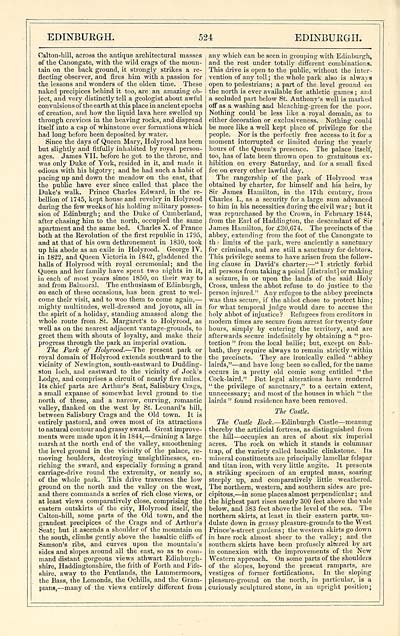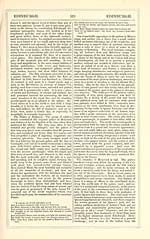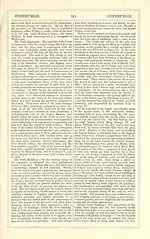Download files
Complete book:
Individual page:
Thumbnail gallery: Grid view | List view

EDINBURGH.
524
EDINBURGH.
Calton-hill, across the antique architectural masses
of the Canongate, with the wild crags of the moun-
tain on the back ground, it strongly strikes a re-
flecting observer, and fires him with a passion for
the lessons and wonders of the olden time. These
naked precipices behind it too, are an amazing ob-
ject, and very distinctly tell a geologist about awful
convulsions of the earth at this place in ancient epochs
of creation, and how the liquid lava here swelled up
through crevices in the heaving rocks, and dispread
itself into a cap of whinstone over formations which
had long before been deposited by water.
Since the days of Queen Mary, Holyrood has been
but slightly and fitfully inhabited by royal person-
ages. James VII. before he got to the throne, and
was only Duke of York, resided in it, and made it
odious with his bigotry ; and he had such a habit of
pacing up and down the meadow on the east, that
the public have ever since called that place the
Duke's walk. Prince Charles Edward, in the re-
bellion of 1745, kept house and revelry in Holyrood
during the few weeks of his holding military posses-
sion of Edinburgh; and the Duke of Cumberland,
after chasing him to the north, occupied the same
apartment and the same bed. Charles X. of France
both at the Revolution of the first republic in 1795,
and at that of his own dethronement in 1830, took
up his abode as an exile in Holyrood. George IV.
in 1822, and Queen Victoria in 1842, gladdened the
halls of Holyrood with royal ceremonial; and the
Queen and her family have spent two nights in it,
in each of most years since 1850, on their way to
and from Balmoral. The enthusiasm of Edinburgh,
on each of these occasions, has been great to wel-
come their visit, and to woo them to come again, —
mighty multitudes, well-dressed and joyous, all in
the spirit of a holiday, standing amassed along the
whole route from St. Margaret's to Holyrood, as
well as on the nearest adjacent vantage-grounds, to
greet them with shouts of loyalty, and make their
progress through the park an imperial ovation.
The Park of Holyrood. — The present park or
royal domain of Holyrood extends southward to the
vicinity of Newington, south-eastward to Dudding-
ston loch, and eastward to the vicinity of Jock's
Lodge, and comprises a circuit of nearly five miles.
Its chief parts are Arthur's Seat, Salisbury Crags,
a small expanse of somewhat level ground to tlie
north of these, and a narrow, curving, romantic
valley, flanked on the west by St. Leonard's hill,
between Salisbury Crags and the Old town. It is
entirely pastoral, and owes most of its attractions
to natural contour and grassy sward. G reat improve-
ments were made upon it in 1844, — draining a large
marsh at the north end of the valley, smoothening
the level ground in the vicinity of the palace, re-
moving boulders, destroying unsightlinesses, en-
riching the sward, and especially forming a grand
carriage-drive round the extremity, or nearly so,
of the whole park. This drive traverses the low
ground on the north and the valley on the west,
and there commands a series of rich close views, or
at least views comparatively close, comprising the
eastern outskirts of the city, Holyrood itself, the
Calton-hill, some parts of the Old town, and the
grandest precipices of the Crags and of Arthur's
Seat; but it ascends a shoulder of the mountain on
the south, climbs gently above the basaltic cliffs of
Samson's ribs, and curves upon the mountain's
sides and slopes around all the east, so as to com-
mand distant gorgeous views athwart Edinburgh-
shire, Haddingtonshire, the frith of Forth and Fife-
shire, away to the Pentlands, the Lammermoors,
the Bass, the Lomonds, the Ochills, and the Gram-
pians, — many of the views entirely different from
any which can be seen in grouping with Edinburgh,
and the rest under totally different combinations.
This drive is open to the public, without the inter-
vention of any toll ; the whole park also is always
open to pedestrians; a part of the level ground on
the north is ever available for athletic games ; and
a secluded part below St. Anthony's well is marked
off as a washing and bleaching-green for the poor.
Nothing could be less like a royal domain, as to
either decoration or exclusiveness. Nothing could
be more like a well kept place of privilege for the
people. Nor is the perfectly free access to it for a
moment interrupted or limited during the yearly
hours of the Queen's presence. The palace itself,
too, has of late been thrown open to gratuitous ex-
hibition on every Saturday, and for a small fixed
fee on every other lawful day.
The rangership of the park of Holyrood was
obtained by charter, for himself and his heirs, by
Sir James Hamilton, in the 17th century, from
Charles I., as a security for a large sum advanced
to him in his necessities during the civil war ; but it
was repurchased by the Crown, in February 1844,
from the Earl of Haddington, the descendant of Sir
James Hamilton, for £30,674. The precincts of the
abbey, extending from the foot of the Canongate to
th ■ limits of the park, were anciently a sanctuary
for criminals, and are still a sanctuary for debtors.
This privilege seems to have arisen from the follow-
ing clause in David's charter: — "I strictly forbid
all persons from taking a poind [distraint] or making
a seizure, in or upon the lands of the said Holy
Cross, unless the abbot refuse to do justice to the
person injured." Any refugee to the abbey precincts
was thus secure, if the abbot chose to protect him;
for what temporal judge would dare to accuse the
holy abbot of injustice? Refugees from creditors in
modern times are secure from arrest for twenty-four
hours, simply by entering the territory, and are
afterwards secure indefinitely by obtaining a " pro-
tection " from the local bailie; but, except on Sab-
bath, they require always to remain strictly within
the precincts. They are ironically called " abbey
lairds," — and have long been so called, for the name
occurs in a pretty old comic song entitled "the
Cock-laird." But legal alterations have rendered
" the privilege of sanctuary," to a certain extent,
unnecessary; and most of the houses in which " the
lairds " found residence have been removed.
Tlie Castle.
The Castle Rock. — Edinburgh Castle — meaning
thereby the artificial fortress, as distinguished from
the hill — occupies an area of about six imperial
acres. The rock on which it stands is columnar
trap, of the variety called basaltic clinkstone. Its
mineral constituents are principally lamellar felspar
and titan iron, with very little augite. It presents
a striking specimen of an erupted mass, soaring
steeply up, and comparatively little weathered.
The northern, western, and southern sides are pre-
cipitous, — in some places almost perpendicular ; and
the highest part rises nearly 300 feet above the vale
below, and 383 feet above the level of the sea. The
northern skirts, at least in their eastern parts, un-
dulate down in grassy pleasure-grounds to the West
Prince's-street gardens ; the western skirts go down
in bare rock almost sheer to the valley ; and the
southern skirts have been profusely altered by art
in connexion with the improvements of the New
Western approach. On some parts of the shoulders
of the slopes, beyond the present ramparts, are
vestiges of former fortifications. In the sloping
pleasure-ground on the north, in particular, is a
curiously sculptured stone, in an upright position;
524
EDINBURGH.
Calton-hill, across the antique architectural masses
of the Canongate, with the wild crags of the moun-
tain on the back ground, it strongly strikes a re-
flecting observer, and fires him with a passion for
the lessons and wonders of the olden time. These
naked precipices behind it too, are an amazing ob-
ject, and very distinctly tell a geologist about awful
convulsions of the earth at this place in ancient epochs
of creation, and how the liquid lava here swelled up
through crevices in the heaving rocks, and dispread
itself into a cap of whinstone over formations which
had long before been deposited by water.
Since the days of Queen Mary, Holyrood has been
but slightly and fitfully inhabited by royal person-
ages. James VII. before he got to the throne, and
was only Duke of York, resided in it, and made it
odious with his bigotry ; and he had such a habit of
pacing up and down the meadow on the east, that
the public have ever since called that place the
Duke's walk. Prince Charles Edward, in the re-
bellion of 1745, kept house and revelry in Holyrood
during the few weeks of his holding military posses-
sion of Edinburgh; and the Duke of Cumberland,
after chasing him to the north, occupied the same
apartment and the same bed. Charles X. of France
both at the Revolution of the first republic in 1795,
and at that of his own dethronement in 1830, took
up his abode as an exile in Holyrood. George IV.
in 1822, and Queen Victoria in 1842, gladdened the
halls of Holyrood with royal ceremonial; and the
Queen and her family have spent two nights in it,
in each of most years since 1850, on their way to
and from Balmoral. The enthusiasm of Edinburgh,
on each of these occasions, has been great to wel-
come their visit, and to woo them to come again, —
mighty multitudes, well-dressed and joyous, all in
the spirit of a holiday, standing amassed along the
whole route from St. Margaret's to Holyrood, as
well as on the nearest adjacent vantage-grounds, to
greet them with shouts of loyalty, and make their
progress through the park an imperial ovation.
The Park of Holyrood. — The present park or
royal domain of Holyrood extends southward to the
vicinity of Newington, south-eastward to Dudding-
ston loch, and eastward to the vicinity of Jock's
Lodge, and comprises a circuit of nearly five miles.
Its chief parts are Arthur's Seat, Salisbury Crags,
a small expanse of somewhat level ground to tlie
north of these, and a narrow, curving, romantic
valley, flanked on the west by St. Leonard's hill,
between Salisbury Crags and the Old town. It is
entirely pastoral, and owes most of its attractions
to natural contour and grassy sward. G reat improve-
ments were made upon it in 1844, — draining a large
marsh at the north end of the valley, smoothening
the level ground in the vicinity of the palace, re-
moving boulders, destroying unsightlinesses, en-
riching the sward, and especially forming a grand
carriage-drive round the extremity, or nearly so,
of the whole park. This drive traverses the low
ground on the north and the valley on the west,
and there commands a series of rich close views, or
at least views comparatively close, comprising the
eastern outskirts of the city, Holyrood itself, the
Calton-hill, some parts of the Old town, and the
grandest precipices of the Crags and of Arthur's
Seat; but it ascends a shoulder of the mountain on
the south, climbs gently above the basaltic cliffs of
Samson's ribs, and curves upon the mountain's
sides and slopes around all the east, so as to com-
mand distant gorgeous views athwart Edinburgh-
shire, Haddingtonshire, the frith of Forth and Fife-
shire, away to the Pentlands, the Lammermoors,
the Bass, the Lomonds, the Ochills, and the Gram-
pians, — many of the views entirely different from
any which can be seen in grouping with Edinburgh,
and the rest under totally different combinations.
This drive is open to the public, without the inter-
vention of any toll ; the whole park also is always
open to pedestrians; a part of the level ground on
the north is ever available for athletic games ; and
a secluded part below St. Anthony's well is marked
off as a washing and bleaching-green for the poor.
Nothing could be less like a royal domain, as to
either decoration or exclusiveness. Nothing could
be more like a well kept place of privilege for the
people. Nor is the perfectly free access to it for a
moment interrupted or limited during the yearly
hours of the Queen's presence. The palace itself,
too, has of late been thrown open to gratuitous ex-
hibition on every Saturday, and for a small fixed
fee on every other lawful day.
The rangership of the park of Holyrood was
obtained by charter, for himself and his heirs, by
Sir James Hamilton, in the 17th century, from
Charles I., as a security for a large sum advanced
to him in his necessities during the civil war ; but it
was repurchased by the Crown, in February 1844,
from the Earl of Haddington, the descendant of Sir
James Hamilton, for £30,674. The precincts of the
abbey, extending from the foot of the Canongate to
th ■ limits of the park, were anciently a sanctuary
for criminals, and are still a sanctuary for debtors.
This privilege seems to have arisen from the follow-
ing clause in David's charter: — "I strictly forbid
all persons from taking a poind [distraint] or making
a seizure, in or upon the lands of the said Holy
Cross, unless the abbot refuse to do justice to the
person injured." Any refugee to the abbey precincts
was thus secure, if the abbot chose to protect him;
for what temporal judge would dare to accuse the
holy abbot of injustice? Refugees from creditors in
modern times are secure from arrest for twenty-four
hours, simply by entering the territory, and are
afterwards secure indefinitely by obtaining a " pro-
tection " from the local bailie; but, except on Sab-
bath, they require always to remain strictly within
the precincts. They are ironically called " abbey
lairds," — and have long been so called, for the name
occurs in a pretty old comic song entitled "the
Cock-laird." But legal alterations have rendered
" the privilege of sanctuary," to a certain extent,
unnecessary; and most of the houses in which " the
lairds " found residence have been removed.
Tlie Castle.
The Castle Rock. — Edinburgh Castle — meaning
thereby the artificial fortress, as distinguished from
the hill — occupies an area of about six imperial
acres. The rock on which it stands is columnar
trap, of the variety called basaltic clinkstone. Its
mineral constituents are principally lamellar felspar
and titan iron, with very little augite. It presents
a striking specimen of an erupted mass, soaring
steeply up, and comparatively little weathered.
The northern, western, and southern sides are pre-
cipitous, — in some places almost perpendicular ; and
the highest part rises nearly 300 feet above the vale
below, and 383 feet above the level of the sea. The
northern skirts, at least in their eastern parts, un-
dulate down in grassy pleasure-grounds to the West
Prince's-street gardens ; the western skirts go down
in bare rock almost sheer to the valley ; and the
southern skirts have been profusely altered by art
in connexion with the improvements of the New
Western approach. On some parts of the shoulders
of the slopes, beyond the present ramparts, are
vestiges of former fortifications. In the sloping
pleasure-ground on the north, in particular, is a
curiously sculptured stone, in an upright position;
Set display mode to: Large image | Transcription
Images and transcriptions on this page, including medium image downloads, may be used under the Creative Commons Attribution 4.0 International Licence unless otherwise stated. ![]()
| Gazetteers of Scotland, 1803-1901 > Imperial gazeteer of Scotland, or, Dictionary of Scottish topography > Volume 1 > (646) Page 524 |
|---|
| Permanent URL | https://digital.nls.uk/97466882 |
|---|
| Description | Volume I: Aan-Gordon. |
|---|---|
| Attribution and copyright: |
|

